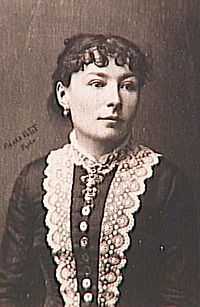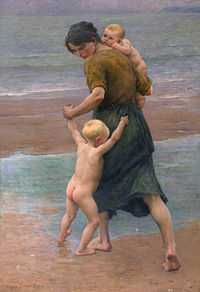Virginie Demont-Breton


Virginie Élodie Marie Thérèse Demont-Breton (26 July 1859, Courrières- 10 January 1935, Paris) was a French painter.
Biography
Her father Jules and her uncle Émile Breton were both well-known painters. She married the painter Adrien Demont in 1880.
Her artistic career got off to an early start. By the age of twenty, she was exhibiting at the Salon and, four years later, she won a Gold Medal at the Amsterdam Exposition.
In 1890, ahe and her husband moved to Wissant, a small village on the Côte d'Opale, where they built a villa designed by the Belgian architect Edmond De Vigne. Called the "Typhonium", it is in Neo-Egyptian style and has been a Historical Monument since 1985.[1]
She served as President of the Union of Women Painters and Sculptors from 1895 to 1901, during which time she worked with Hélène Bertaux in her effort to open the École des Beaux-Arts to women students; a goal which was achieved in 1897. She was decorated with the Légion d'honneur in 1894,[2] and became an Officer in 1914. The previous year, she had been elected to the Royal Academy of Fine Arts (Antwerp) in 1913
Originally, she painted portraits and historical scenes but, after moving to Wissant, switched to painting the fishermen and their families in a Realistic style. In 1889, Vincent van Gogh painted his own version of one of her works, "L’Homme Est en Mer" (Her Man is Out to Sea).
Writings
- Tendresses dans la tourmente. 1914-1919 poésies, Alphonse Lemerre, Paris 1920
- Les maisons que j'ai connues. Plon-Nourrit, Paris 1926
References
- ↑ Register of Historical Monuments @ the Base Mérimée.
- ↑ Dossier @ the Base Léonore.
Further reading
- Visages de Terre et de Mer - Regards de peintres à Wissant à la fin du 19è siècle, ouvrage collectif, Michèle Moyne-Charlet, Anne Esnault, Annette Bourrut Lacouture, Yann Gobert-Sergent, édition du Pas-de-Calais, SilvanaEditoriale, août 2014, 135 pages.
- Yann Gobert-Sergent, "Virginie Demont-Breton (1859-1935), Peintre et témoin de la vie des marins de la Côte d’Opale", in the Revue Boulogne et la Mer, #14, July 2008, pages 4–7.
- Annette Bourrut-Lacouture, "Virginie Demont-Breton (1859-1935) peintre de Wissant. La famille, la mer et les mythes fin de siècle", Bononia, #19, 1991, pages 36–45.
External links
| Wikimedia Commons has media related to Virginie Demont-Breton. |
- ArtNet: More works by Demont-Breton
- Brief biography and appreciation of her work @ Demontbreton.free.fr
- Biography @ Wiki Pas-de-Calais.
|